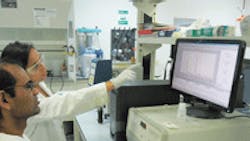For 26 years -- ever since the discovery of the buckyball in 1985 -- nanotechnology has promised industry opportunities to improve products. Nanotechnology can make products lighter, stronger or more efficient, yet the technology revolution predicted by some proponents has yet to be fully realized.
That's not to say nanotechnology isn't making progress toward real-world applications. In paints, drugs and a host of other industries, nanotechnology has made significant inroads toward fulfilling its promise. But along with greater adoption, nanotechnology is facing increased scrutiny, centered on possible effects on human health, animal health and the environment.
Environmental studies are under way, and many experts are confident the science will show no more threat to health and safety than other technologies of the past. Once it gets a clean bill of health, these experts say, industry's investment in nanotechnology will skyrocket.
Where We Are Now
Ning Xi, president of the Nanotechnology Council for IEEE and a professor at Michigan State University, says nanotechnology is at something of a midpoint in its development.
Photo: Quartek Corp.
Xi says there are three areas where nanotechnology is on the cusp of being used extensively if only a standardized manufacturing process can be developed. He says the semiconductor, biomedical and solar panel manufacturing industries are waiting to incorporate nanoparticles into their products.
"These are areas where nanotechnology would be extremely useful, but there's a bottleneck right now," Xi says. "We're waiting for an easy integration into existing manufacturing processes -- and that's where the scientists are putting their energies right now."
Health and Safety Concerns
The Piedmont Triad, a triangle of three cities -- Winston-Salem, Greensboro and High Point -- in north-central North Carolina, is a hotbed for nanotechnology development. It is home to The Joint School of Nanoscience & Nanoengineering (a joint-venture between North Carolina A&T State University and the University of North Carolina-Greensboro) and The Center for Nanotechnology and Molecular Materials at Wake Forest. It's also home to numerous nanotechnology startups.
Scientists at all those schools and companies are excited about what nanotechnology can do, but they recognize the difficult regulatory environment into which these technologies are being born.
David Carroll, director of The Center for Nanotechnology and Molecular Materials and associate professor of physics at Wake Forest in Winston-Salem, says concerns remain in the United States and Europe over the health and environmental effects of substances like nanosilver and carbon nanotubes. Carroll says the European Union (EU) has already heard arguments about banning both.
"If they're successful, it will have effects on manufacturing and the use of nanomaterials," Carroll says. "I believe it's an overreaction based on too little science. We just don't know the full extent of what we're looking at. There's still a lot of work to be done."
Carroll says science groups like his at Wake Forest are working on manufacturing methods that will limit the release of nanoparticles into the environment. He worries that further restrictions will have a deleterious effect on the United States' ability to compete in nanotechnology worldwide.
"We've already ceded a lot of ground to China," Carroll says. "If we continue to do so, it's going to cause us problems in the future."
Reyad Sawafta, president and CEO of QuarTek Corp. in Greensboro, says the biggest challenge facing nanotechnology producers is the silence from regulators.
"There's been this backlash in recent years against nanotechnology, and it's often by people who don't understand it," Sawafta says. "That's made the regulators hesitant to speak on the issue, and that makes it hard to commercialize the technology."
What's important is not letting fear govern the development of nanotechnology, says James Ryan, founding dean of the Joint School of Nanoscience & Nanoengineering in Greensboro.
"Nanoparticles have existed forever -- they exist in nature," Ryan says. "We need to develop safety protocols for their use so that people can understand better what nanotechnology is and what the risks are. Once you understand the risks, if there are any, you can mitigate them."
At the end of the day, Ryan says, a common-sense approach to nanotechnology will open up vistas that no one can currently envision.
"We're finding new applications for nanotechnology every day," Ryan says. "If we are sensible about the way we approach their use, it could revolutionize manufacturing."
